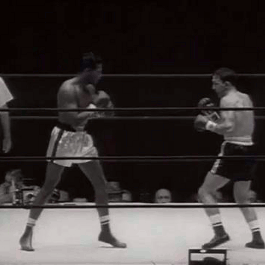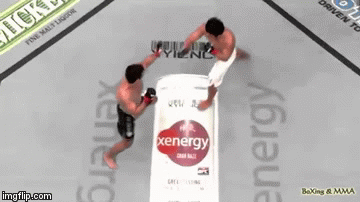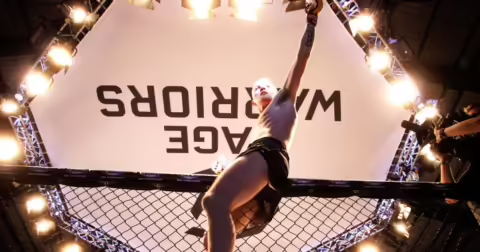So last week we basically covered the parallels between the origins of boxing (since filmed Queensberry rules) and the beginnings of MMA (since the UFC before the Unified Rules of MMA and after) and how they dealt with evasive movement. We found that boxers were quick to learn how to deal with punches and also how to punch and control their body more efficiently. Small things like bending at the waist, tucking the chin, and how to move.
The last part is the most important. How to evade punches with footwork and head movement and not just with their hands. This quickly became the norm and all the Greatest fighters had not only fantastic movement, but it was also unique to them.
“Sugar” Ray Robinson:

Roy Jones Junior:

Floyd Mayweather:

… And I posted the Greatest, Muhammad Ali, last week.
Within the individual movement amongst great fighters are some common factors (and indeed all fighters) such as footwork, head movement, and hand placement.
The thing about MMA is there are so many more ways to lose. Takedowns change the distance and the need for hand placement.
Enter Anderson Silva.
Anderson “The Spider” Silva had a very good initial career, but once he got in the cage he truly mastered his craft. He figured out that keeping his hands low meant that his hands were always there for the defence of takedowns.
Example of Silva’s defensive head movement, with hands low:

Having the hands low was two-fold; Firstly, it invited opponents to hit him, opening them for counters. His highlight reel is filled to the brim with amazing head movement, creativity and counters. The second reason was to defend takedowns. When you have your hands low you are halfway to defending a shot. The first line of defence is pushing their head or shoulders away with your hands. There are obvious flaws when you apply this to MMA. Touching someone lets them know you’re in range and are available to get hit. next line of defence is under-hooks, and that’s what Anderson wants.
Under-hooks, clinch, pummel to Thai clinch. knee, repeat.
This was one of the first real glimpses of evasive movements used in MMA. Footwork was at a minimum and served its purpose which was to stay right in front of the opponent and make them miss. Although it doesn’t look like a lot Silva always kept in just the right range, which for him was at the very edge of his opponents punching range. He leans forward, inviting the punch, then moves his head and counters.
Pretty much the boxing mantra of “hit and don’t get hit” but the other way around; “Don’t get hit and then hit”. He had some boring fights but as soon as he knocked someone out, normally in spectacular fashion, we quickly forgave.
This was the first real example of avoiding getting hit whenever possible, and it was a high bar to set. A style that is particularly hard to emulate, although it is now shining through, embodied by stand out Bellator fighter, Michael “Venom” Page:

Same stance, defending the takedowns with low hands. Something I hope to see a lot more of.
Interestingly although I’ve referenced boxing and boxing tactics, neither combatant came from boxing specifically. Silva came from the famed Chute Boxe Academy where Muay Thai is the standard. MVP (before he joined London Shootfighters) was a freestyle point fighter. Traditional Kung Fu (Lau Gar) and karate competitions.
Leading me on to my next evasive stylist – The Dragon.
Lyoto Machida came shortly after his team-mate Anderson. One year after Silva’s UFC debut, Machida had his. He was a counter striker but with a different goal. Counter then sweep.

His takedown skills mostly came from a Sumo/Karate background, which came from full contact fights such as this:

His style ensured that he didn’t take much damage, and if it went to the ground then he had top control. He also embodied the mindset of Karate. One shot, one kill. He showed the Karate mindset most when he fought C.B Dollaway. For a full minute, Machida keeps range, giving away nothing and staying well out of range. Then one precision kick to the liver and it was all over. An economy of motion and zero damage to himself.
His movement is unique in that his feet stay almost always in the same position, always ready to strike and move at the same time. He dives into range. Not in the same way most karate fighters do, which is to get in range to strike and then dive out. He goes to trapping range, trips his opponent, then decides what he wants to do. Not many fighters make use of the trapping range but Machida’s Karate background is made for it.
Now we are in the most modern era of MMA. Fighters are diversifying their movement. there are a few fighters at the forefront of this. Stephen “Wonderboy” Thompson has taken martial arts full circle with his most traditional interpretation of Karate. Unlike Machida, Thompson has more head movement and is a lot looser. He dives straight in and straight out, avoiding punches, knees, elbows, kicks, all to deliver his own bone-crunching strikes, then jumps out of range, untouched.

Wonderboy’s way of avoiding takedowns is to literally just not be there. He practically runs backwards and when his opponent realises they are out of reach, they throw punches. Wonderboy is far too good as this is his bread and butter and he counters whilst striking off the back foot.

His hands are also low, to defend takedowns. He does this because he was taught in Karate as a style though, rather than showboating it was for defending body kicks. The stance has integrated very well with his style in MMA.
Of course, one man who is “Notorious” for his employment movement is Conor McGregor. “They don’t move like I move, they don’t think like I think!”
He is someone who preaches movement, fluidity and economy of motion. He is a southpaw (A southpaw is someone who fights with their right side forward) but it doesn’t count for as much in MMA, as a lot of other fighters are southpaws or guys who switch stances at will. What IS different though is that he is not a southpaw by choice.
The majority of southpaws that fight in the UFC come from wrestling. In wrestling having your right foot forward is considered the “orthodox” way of doing things. It’s the dominant driving leg to shoot for takedowns. When they transition to MMA they have two choices. Learn to strike as a southpaw with an awkward dominant hand or learn to fight orthodox and have a better chance at learning how to jab, but perhaps more awkward learning to shoot again.
McGregor is not a southpaw by choice as he started in boxing. Your first lesson in boxing is always started with a question: “Are you right-handed or left-handed?”
McGregor learned to box naturally and at a much earlier age. He was training boxing in his teens as well as BJJ. He started early and it has counted for a lot. Being a southpaw gives an edge because there are so few of them, making them hard to emulate and train for.
Conor’s stance is wide and low and not a “traditional” – You can go back to the first article and see a picture of Bas Rutten for an example – MMA. If I had to describe it, it would be asymmetrical harmony between Karate and Boxing. All his kicks are chambered and change directions, and he stays at a range but his punches are non-telegraphed to the extreme. He doesn’t pull back to get power, so his weight doesn’t shift backwards, save for when he is trying to knock people out. Even then it only goes in one direction and that is through his opponent.
His footwork is minimal because opponents are often the ones running away from him and his left hand. His right hand is often outstretched to gauge a range to strike. Note that this is not regular even for boxing. He gets away with it because he is a southpaw.
His right-hand finding range:

And see that McGregor stays at EXACTLY that range or just outside of it.
Notice his right hand a split second before countering, again, finding range:

I also feel that this second gif captures beautifully just how good McGregor’s head movement can be.
You might be wondering why fighters don’t simply take him down or kick his legs and cut his movement. Other than Chad Mendes and Diaz, Conor’s fights tend to be one-sided stand-up wars. The simple answer is power and range. McGregor is good at holding his range. Because he is a southpaw and because he has long arms, he has a deceptive reach. Fighters can look like they are just taking punches and not doing anything when in reality they don’t think he is close enough. He is close enough and he is fast enough.
He also makes them timid. If you hit someone hard the first time they tend to be cautious about the next exchange. “Make ’em miss, make ’em pay”. When you’re cautious, you’re tight, when you’re tight, you hesitate, when you hesitate, you lose reaction time and get caught. Two big examples of this are his fights with Brandao and Alvarez.
Timidity personified. Not running away, but accepting the outcome:

Alvarez whilst not as bad appeared extremely hesitant after the first knockdown. He was too scared to find his range in front of McGregor and hence started throwing wildly, making it easy for Conor to counter.
And so this is the way fighting is evolving. The new school vs the old school. Right now battling it to a draw, according to Woodley vs Thompson. The old school will soon just become “the fundamentals” and the new school will become “the necessary”. You’ll have to learn it all just to counter it all.
The movement inside the Octagon may be entirely different ten years from now, like the difference between boxing then and boxing now. We don’t know what the future holds, but we know what works and we are finding more of it every time two guys put on the gloves.



 Subscribe
Subscribe





